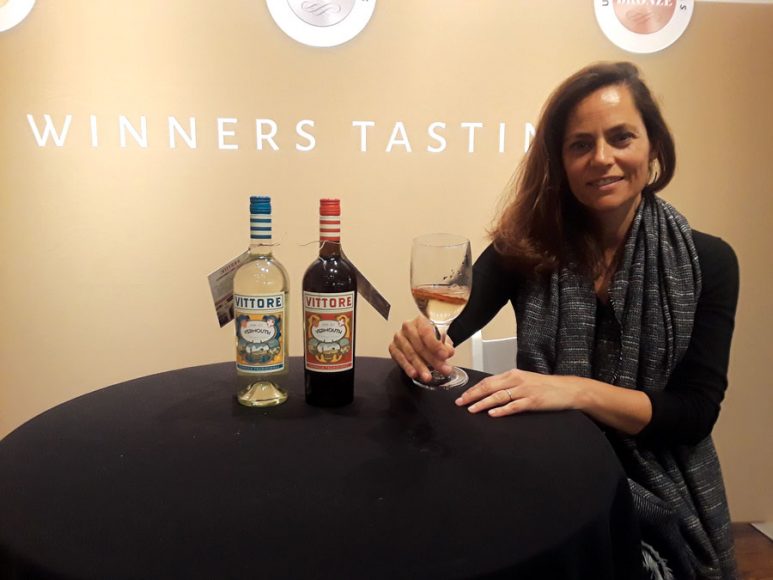So who uses vermouth anymore, anyway? I was a bartender on Nantucket in the mid 1970s at a few fancy restaurants. Diners would often order up a martini or a Manhattan. Then the martini became the “dry” martini and then “very dry.” The standard martini had a ratio of 1:2 of vermouth to gin or vodka. The dry martini had a ratio from 1:4 to 1:6 or so. And I remember a gentleman asking for an “Extra dry Beefeaters martini and I’m going to tell you how to make it. Grab the shaker, scoop in some ice. Add the Beefeaters, uh, a little more. There, now lift the dry vermouth bottle and wave it upright over the shaker glass and return it to the well. Now, shake vigorously and strain into a martini glass and swipe a lemon rind around the rim and drop it in the glass. Ahhhh. Perfect.” Quite quickly I witnessed the disappearing vermouth.
Vermouth was originally created as a medicinal elixir and was altered to address whatever ailment was presenting. The medical doctor or witch doctor or midwife would concoct a drink using fortified wine as the base and add ground-up roots, bark, leaves, berries and any assortment of botanicals for taste and reputed health benefits. As distillation — that is, turning a low-alcohol drink like beer or wine, into a high- alcohol spirit — was popularized, other drinks were tweaked to add to and soften the edginess and heat of the alcohol. Ports, Madeiras and Sherries, among others, were sometimes used for the same effect — to lower the alcohol levels and to soften the bite of distilled spirits.
On a recent trip to the Valencia region of Spain, I met Marta Valsangiacomo, the young and dynamic matriarch of Bodegas Cherubino Valsangiacomo. Her wine roots go back generations and span a few countries. Her great-grandfather, Don Benedetto Valsangiacomo, bought and planted some vineyards in Switzerland and created a following with some attractive wines while developing a personal recipe for both sweet and dry vermouths. But the phylloxera scourge set in, destroying his vines. (Phylloxera is a small louse that sucks on the plant at soil level and has killed hundreds of thousands of acres of thriving vineyards on all continents and in all countries.) Control option number one is to replant the entire vineyard using American rootstock, which is impervious to the attack. Option number two is to relocate the family to another area and start over. The family chose option two, set out for Spain and settled into the thriving seaport of the Valencia region on the east-central coast.
Since that time they have planted and bought up vineyards or acreage on which to plant and today produce more than 10 million bottles a year, making them one of the major players in the region. They have roots in the Valencia DO, or Denomination of Origin, the local wine governing body, and in the adjacent Utiel-Requena DO. I recently met with Marta at a New York trade show and tasted and learned about her family’s vermouth, which is a key ingredient to Rob Roys and Negronis as well as martinis and Manhattans. Both the dry and the sweet vermouth are simply loaded with flavor. I asked Marta how she drinks Vermouth. “I like it as is. A good glass, some ice, dry or sweet vermouth depending on my mood, and a sliver of lemon or orange. And that’s it.”
The recipe created by Don Benedetto is essentially this: Make a wine. Before fermentation is complete, add a high alcohol neutral grape brandy to kill the yeasts, maintaining some of the natural grape sugars. Then add myriad plant products and botanicals for the chosen flavor profile. At Bodegas Cherubino Valsangiacomo, common botanicals such as coriander, salvia, oregano, chamomile and orange are used along the lesser known genciana, ajenjo and ajedrea to provide a three-dimensional flavor and mouthfeel.
My next stop at this trade show was a nearby gin producer. He beckoned me over and poured me a taste. It wasn’t quite cold enough and, yes, it had a present alcohol heat to it that made it taste a bit imbalanced. I went back to Marta and asked her for a light splash of her dry vermouth in the gin glass. It was instantly drinkable, balanced and delicious. Both the dry and sweet vermouth go by the name Vittore Vermouth. They also produce a riserva Vittore Vermouth. Think of it as adding an additional tasty parameter to your vodka, your gin or your whiskey glass. Or just pour a glass as Marta does. Ice and vermouth. Let the Vittore Vermouth wow you.
Write me at doug@dougpaulding.com.


